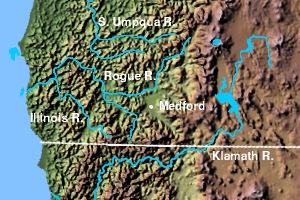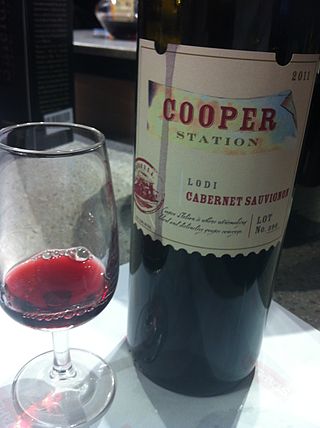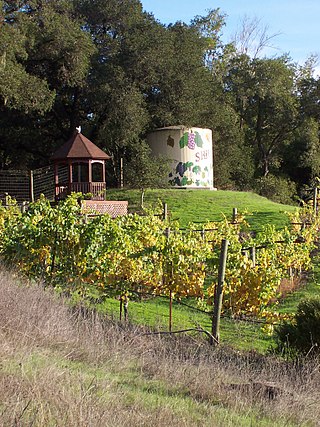Related Research Articles

The Alexander Valley is a Californian American Viticultural Area (AVA) just north of Healdsburg in Sonoma County. It is home to many wineries and vineyards, as well as the city of Cloverdale. It is the largest and most fully planted wine region in Sonoma. Highway 101 runs through the valley, and the Russian River flows down the valley, surrounded by vineyards on both sides. From the higher elevations of the valley rim, there is a view as far south as Taylor Mountain and Sonoma Mountain. The region was named for Cyrus Alexander, owner of a part of the Rancho Sotoyome Mexican land grant, in 1847. Granted AVA status in 1984, the boundaries of the appellation are defined in the Code of Federal Regulations, Title 27, Section 9.53.

Ridge Vineyards is a California winery specializing in Cabernet Sauvignon, Zinfandel, and Chardonnay wines. Ridge produces wine at two winery locations in northern California. The original winery facilities are located at an elevation of 2,300 feet on Monte Bello Ridge in unincorporated Santa Clara County in the Santa Cruz Mountains AVA, south of Los Altos, California and west of Cupertino, California. The other Ridge winery facilities are at Lytton Springs in the Dry Creek Valley AVA of Sonoma County. Ridge Vineyard's 1971 Monte Bello Cabernet Sauvignon gained prominence for its fifth-place finish in the 1976 "Judgment of Paris" wine tasting.

The Southern Oregon AVA is an American Viticultural Area which lies in Southern Oregon, United States. The Southern Oregon AVA was established in 2005 and was created to include the land of two smaller AVAs: the Rogue Valley AVA and the Umpqua Valley AVA. Southern Oregon AVA was established to allow the two principal winegrowing regions in the southern part of the state to market themselves jointly. This creation of a "super-AVA" is a departure from the trend in the Willamette Valley AVA or northern Oregon of establishing smaller AVAs specific to a particular locale's climate or soil conditions.

The Rogue Valley AVA is an American Viticultural Area located in southern Oregon. The federal government approved this appellation in 1991. It is entirely contained within the larger Southern Oregon AVA and includes the drainage basin of the Rogue River and several tributaries, including the Illinois River, the Applegate River, and Bear Creek. Most wineries in the region are found in the valleys formed by one of these three tributaries, rather than along the Rogue River itself. The region is 70 miles (113 km) wide by 60 miles (97 km) long ; there are fewer than 20 wineries with only 1,100 acres (450 ha) planted. Each river valley has a unique terroir, and grows different varieties of grapes. Overall, however, this region is the warmest and driest of Oregon's wine-growing regions.
Knights Valley AVA is an American Viticultural Area (AVA) in Sonoma County, California. One of Sonoma County's original five AVAs, Knights Valley AVA was formally designated an American Viticultural Area on October 21, 1983. Knights Valley AVA includes approximately 37,000 acres (150 km2). Over 30 growers maintain the 2,000 acres (8 km2) planted to wine grape vineyards. The easternmost designated Sonoma County wine region, Knights Valley AVA has the warmest climate in the county. The valley lies between the Alexander Valley AVA and Chalk Hill AVA wine regions to the west and the Mayacamas Mountains to the east. Geographically, the appellation separates the rest of Sonoma County from the Napa Valley AVA.

The Mendocino County wine is an appellation that designates wine made from grapes grown mostly in Mendocino County, California. The region is part of the larger North Coast AVA and one of California's largest and most climatically diverse wine growing regions. Mendocino County is one of the northernmost commercial wine grape regions in the state with two distinct climate zones separated by the Mendocino Range. Ten American Viticultural Areas have been designated within Mendocino County. Mendocino is one of the leading wine growing regions for organically produced wine grapes. Nearly 25% of the acreage in Mendocino County is grown organically. In 2004, the residents of the county voted to become the first GMO-free county in the United States in an initiative that was supported by many of the county's largest wineries. The county's widespread focus on organic viticulture has inspired journalists to describe it as "California's organic wine Mecca".

Sonoma County wine is wine made in Sonoma County, California, in the United States.

Lodi AVA is an American Viticultural Area located in the Central Valley of California, at the northern edge of the San Joaquin Valley east of San Francisco Bay. The AVA gained approval as a designated wine growing area in 1986 and includes 551,000 acres (223,000 ha) of which 103,000 acres (42,000 ha) are currently planted with wine grapes. In 2002, the area included in the AVA was expanded by 93,500 acres (37,800 ha) along the southern and western portions of the original AVA boundaries in San Joaquin County. The appellation includes land in southern Sacramento County and northern San Joaquin County. It is bounded on the west by Interstate Highway 5 and to the east by the political borders for the adjacent El Dorado, Amador, and Calaveras Counties.
The Mendocino Ridge AVA is a coastal, cool climate and high altitude American Viticultural Area located entirely within the coastal zone of Mendocino County, California. The boundaries of the AVA encompass the coastal ridges adjacent to the Pacific Ocean that reach inland toward the Anderson Valley. Roughly 36 miles of the southernmost portion of the Mendocino Coast make up the western boundary of the AVA, with the Sonoma County line as the southern boundary, the Navarro River as the northern boundary and Anderson Valley as the inland boundary running northwest–southeast. The Mendocino Ridge AVA "is essentially a northern extension of the true Sonoma Coast viticultural area." However, the Mendocino Ridge AVA designation is unique in that it is limited by elevation, reserved only for vineyards at or above 1200 feet. This means Mendocino Ridge is the only non-contiguous AVA in the United States. The Mendocino Ridge AVA has been nicknamed "Islands in the Sky," because the thick fog moving inland from the Pacific Ocean blankets the coast and the valleys between the ridge tops, making the tops of the mountains, where the vinyards lay, look like islands protruding from a sea of fog. The Mendocino Ridge AVA lands are above the Anderson Valley and Mendocino appellations. The Mendocino Ridge viticultural area boundary encompasses 262,400 acres, but the actual viticultural area contains only 87,466 acres. Of these, approximately 1,500 to 2,000 acres are suitable for vineyards. The loczl hillsides are very steep and covered with timber, making them unfit for planting. Estimates of planted acres range from 233 to 410, which accounts for about 0.3% of the total area.
The Bennett Valley AVA is an American Viticultural Area located in Sonoma County, California. The boundaries of this appellation lie completely within the North Coast AVA, almost completely within the Sonoma Valley AVA and overlaps into some areas of the Sonoma Coast AVA and Sonoma Mountain AVA. The region was granted AVA status on December 23, 2003 following the petition of Matanzas Creek Winery. The AVA is surrounded to the south, east and west by the Sonoma Mountains and to the north by the city of Santa Rosa, California. The region receives a moderating effect on its climate from Pacific Ocean through the cool coastal fogs and breeze that creep into the area from the southwest through Crane Canyon between Sonoma Mountain and Taylor Mountain. Barbera, Cabernet Sauvignon, Cabernet Franc, Chardonnay, Grenache, Merlot, Pinot noir, Sauvignon blanc and Syrah are the leading grape varieties planted.

The Chalk Hill AVA is an American Viticultural Area (AVA) located in Sonoma County, California. The boundaries of the wine appellation cover the northeast corner of the Russian River Valley AVA. The majority of vineyards are located to the east of U.S. Route 101, near the town of Windsor. The name Chalk Hill comes from the unique volcanic soil of chalky white ash which has shown itself to perform well with planting of white wine varietals like Chardonnay and Sauvignon blanc. The majority of the region's wineries are located on the western slopes of the Mayacamas Mountains.

The Dry Creek Valley AVA is an American Viticultural Area in Sonoma County, California, located northwest of the town of Healdsburg. The valley is formed by Dry Creek, a tributary of the Russian River, and is approximately 16 miles (25.7 km) long and 2 miles (3.2 km) wide. The appellation benefits from the proximity of the Lake Sonoma reservoir for irrigation in this relatively dry area.

The Russian River Valley AVA is an American Viticultural Area (AVA) in Sonoma County, California. Centered on the Russian River, the Russian River Valley AVA accounts for about one-sixth of the total planted vineyard acreage in Sonoma County. The appellation was granted AVA status in 1983 and enlarged in 2005. The area generally lies between Sebastopol and Santa Rosa in the south, and Forestville and Healdsburg in the north. The Russian River Valley has a characteristically cool climate, heavily affected by fog generated by the valley's proximity to the Pacific Ocean. The area is known for its success with cool climate varietals, notably Pinot noir and Chardonnay.
The Sonoma Mountain AVA is an American Viticultural Area in Sonoma County, California, United States. It is centered on the Sonoma Mountain landform in the Sonoma Mountains. The appellation includes the town of Glen Ellen, California and is nearly surrounded by the Sonoma Valley AVA. The area is known for the diverse micro-climates that occur on exposed hillsides and shaded drainages, and as such is home to production for a wide range of varieties including Cabernet Sauvignon, Chardonnay, Pinot noir, Sauvignon blanc, Semillon, and Zinfandel.

St. Helena is an American Viticultural Area (AVA) located within Napa Valley, centered in and around the town of St. Helena, California. It was established by the Bureau of Alcohol, Tobacco and Firearms (ATF) on October 11, 1995, after the ATF received a petition from Mr. Charles A. Carpy, Chairman of the St. Helena Appellation Committee, proposing to establish a new viticultural area in Napa County to be known as "St. Helena."
The Chiles Valley is an American Viticultural Area (AVA) located in Napa County, California and a sub-region within Napa Valley AVA. It was established as California's 81st AVA by the Bureau of Alcohol, Tobacco and Firearms (ATF) on April 19, 1999 after the ATF received the petition from Mr. Volker Eisele, owner of the Volker Eisele Vineyard and Winery proposing a new viticultural area in Napa County to be known as "Chiles Valley District".

The Spring Mountain District AVA is an American Viticultural Area located in the Napa Valley AVA in California. Spring Mountain District AVA was officially established as an American Viticulture Area in 1993. Encompassed within its bounds are about 8,600 acres (3,480 ha), of which about 1,000 acres (400 ha) are planted to vineyards. Given the small crop yields on hillsides, the region represents less than 2% of Napa Valley wine. Currently the region has just over 30 winegrowers.

California wine production has a rich viticulture history since 1680 when Spanish Jesuit missionaries planted Vitis vinifera vines native to the Mediterranean region in their established missions to produce wine for religious services. In the 1770s, Spanish missionaries continued the practice under the direction of the Father Junípero Serra who planted California's first vineyard at Mission San Juan Capistrano.

Kenwood Vineyards is a winery in Kenwood, California, located on Highway 12 in the Sonoma Valley wine country. It is currently owned by Pernod Ricard Winemakers.
Kelsey Bench-Lake County is an American Viticultural Area located in Lake County, California. The area is home to some 900 acres of vines in 27 vineyards, and was officially established as an AVA by the Alcohol and Tobacco Tax and Trade Bureau (TTB) in October 2013. Sauvignon blanc, Chardonnay, Viognier and Riesling are the principal white grape varieties within Kelsey Bench and its neighbor the Big Valley District AVA. Zinfandel, Merlot and Cabernet Franc varieties make up the majority of red grape plantings in the area.
References
- ↑ "§ 9.70 Northern Sonoma" (Title 27: Alcohol, Tobacco and Firearms; Part 9 — American Viticultural Areas; Subpart C — Approved American Viticultural Areas). Code of Federal Regulations. Retrieved January 4, 2008.
- 1 2 3 "Northern Sonoma (AVA): Appellation Description". Appellation America. 2007. Archived from the original on February 4, 2009. Retrieved January 4, 2008.
- 1 2 Selinger, Hannah (6 November 2020). "Diverse Soils and Coastal Winds: The Ultimate Guide to Sonoma". Wine Enthusiast. Retrieved 17 August 2021.
- 1 2 "Northern Sonoma Wine Region and Appellation". Sonomacounty.com. Retrieved 17 August 2021.
38°30′N122°48′W / 38.5°N 122.8°W